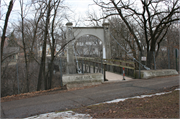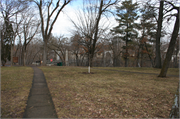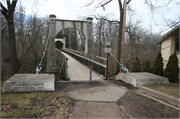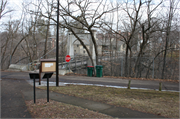End of W Cascade Avenue, across the South Fork Kinnickinnic River
| Historic Name: | Glen Park Suspension Footbridge |
|---|---|
| Reference Number: | 100002671 |
| Location (Address): | End of W Cascade Avenue, across the South Fork Kinnickinnic River |
|---|---|
| County: | Pierce |
| City/Village: | River Falls |
| Township: |
| Glen Park Suspension Footbridge End of W Cascade Avenue, across the South Fork Kinnickkinnic River City of River Falls, Pierce County Designer: Minneapolis Bridge Company Date of Construction: 1925
The Glen Park Suspension Footbridge crosses the high, rocky banks of the South Fork Kinnickinnic River and connects the north side of River Falls with Glen Park, the city’s oldest and largest recreational facility. Designed and built by the Minneapolis Bridge Company in 1925, the cable suspension bridge consists of two poured-concrete anchorages and towers at each bank that are connected by two spun-steel suspender cables that carry a wooden deck structure via regularly placed steel suspension rods. The bridge is 190 feet long with a 130-foot center span and thirty-foot outer spans. The bottom of the deck is approximately forty-four feet above the South Fork Kinnickinnic River. The bridge is approximately twenty-five feet wide between the anchorages and approximately fourteen feet wide between the towers.
Located in the west central portion of River Falls south of the two rivers that divide the city, Glen Park emerged as a result of the glen and waterfall on the South Fork Kinnickinnic River created by the dam constructed for a local mill. The picturesque spot soon was made accessible to picnickers and hikers by primitive steps extending from the top of the bank and a low, primitive footbridge over the river. This footbridge repeatedly was washed out by floods and then rebuilt. By 1900, the city had obtained twenty-one wooden acres south of the river and it became known as City Park.
Noted as the leading service organization in the history of the city, the River Falls Women’s Improvement League organized in 1900 “to organize a permanent society whose object should be to assist in beautifying the homes, streets and surroundings in River Falls and to promote in every legitimate way the best development of the whole city.” The League emerged at a time nationally when women more and more were creating a wide range of groups to tackle social and political issues, as well as promote health, education and civic improvement. The group sponsored improvements throughout the city including several at Glen Park. They sponsored the construction of the early 1920s primitive footbridge across the South Fork Kinnickinnic River but the historic record indicates they were not responsible for the construction of the current bridge.
Sensitively rehabilitated in 1985-1986, the Glen Park Suspension Footbridge is significant as a well-designed and rare example of a cable suspension bridge in Wisconsin. |
| Period of Significance: | 1925 |
|---|---|
| Area of Significance: | Engineering |
| Applicable Criteria: | Architecture/Engineering |
| Historic Use: | Transportation: Pedestrian Related |
| Architectural Style: | No Style Listed |
| Resource Type: | Structure |
| Architect: | Minneapolis Bridge Company |
| Historic Status: | Listed in the State Register |
|---|---|
| Historic Status: | Listed in the National Register |
| National Register Listing Date: | 07/13/2018 |
| State Register Listing Date: | 02/16/2018 |
| Number of Contributing Buildings: | 0 |
|---|---|
| Number of Contributing Sites: | 0 |
| Number of Contributing Structures: | 1 |
| Number of Contributing Objects: | 0 |
| Number of Non-Contributing Buildings: | 0 |
| Number of Non-Contributing Sites: | 0 |
| Number of Non-Contributing Structures: | 1 |
| Number of Non-Contributing Objects: | 0 |
| National Register and State Register of Historic Places, State Historic Preservation Office, Wisconsin Historical Society, Madison, Wisconsin |





